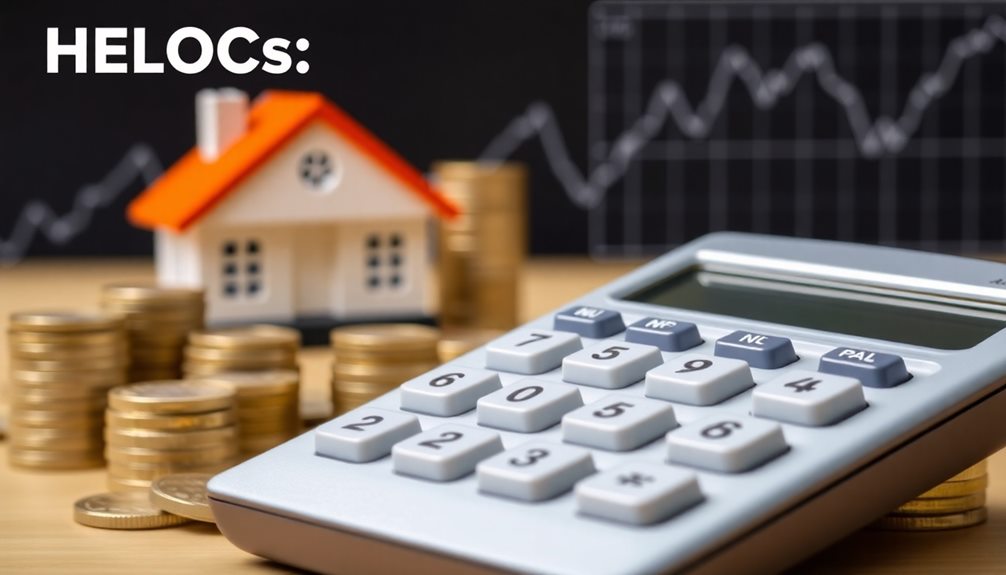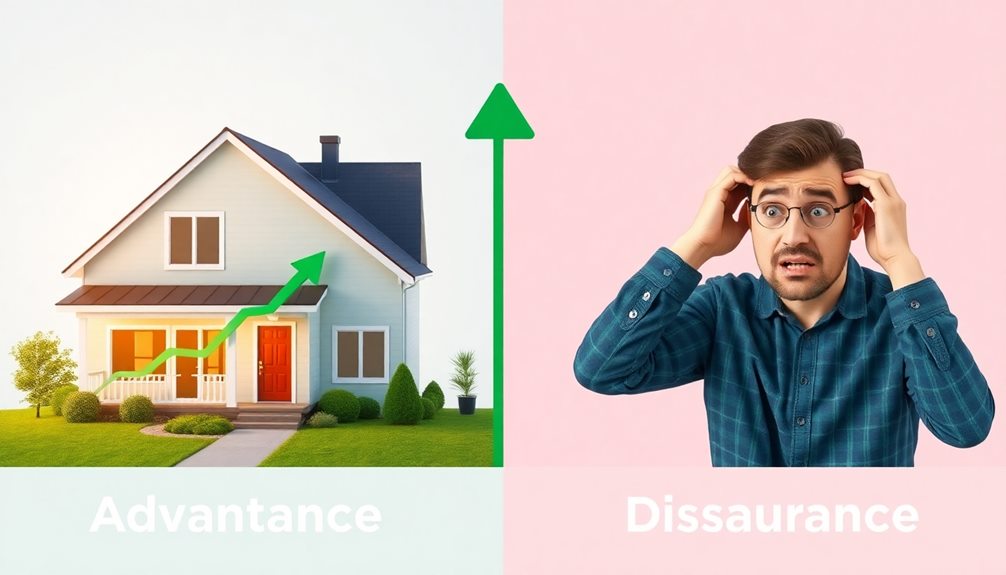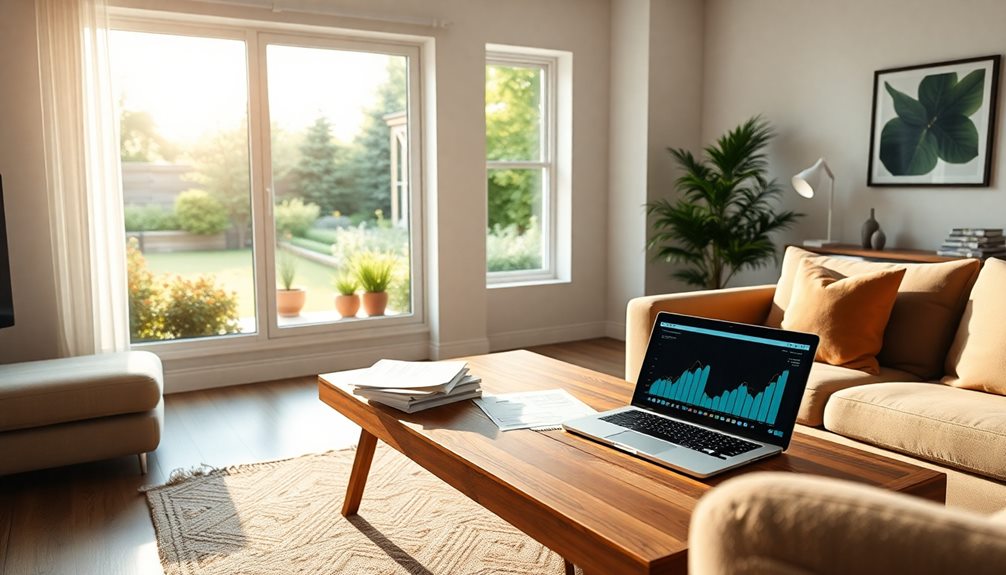When you're considering a Home Equity Line of Credit (HELOC), you'll find rates typically range from 7.25% to around 10%, depending on your credit score and loan-to-value ratio. Lenders like Citizens Bank and Bank of America offer competitive rates starting at about 8.50%. Remember, the draw period lasts 10 years, followed by a 20-year repayment phase. Be aware of potential application and closing costs, which can add up. Each lender varies in terms and benefits, so comparing options can save you money. Discover how to make the best choice for your needs along your financial journey.
Key Takeaways
- Current HELOC rates typically range from 8% to 10%, with a national average around 8.5% as of late 2024.
- Citizens Bank and Bank of America offer competitive rates starting at 8.50% with no closing costs or application fees.
- Truist and Fifth Third Bank provide options to lock in fixed rates during the draw period for added security against rising rates.
- Consider the total costs associated with HELOCs, including application fees, ongoing costs, and fluctuating interest payments linked to your credit profile.
- Higher credit scores and lower loan-to-value ratios can help secure better HELOC terms and lower interest rates.
Understanding HELOC Basics

Understanding the ins and outs of a Home Equity Line of Credit (HELOC) can empower you to make informed financial decisions. A HELOC is a revolving line of credit secured by your home equity, allowing you to borrow against that equity much like a credit card.
Typically, a HELOC has a 10-year draw period where you can withdraw funds and make interest-only payments. After that, a 20-year repayment period kicks in, requiring you to pay both principal and interest.
Your maximum borrowing limit can reach up to 80% of your home equity, which may increase as you pay down your mortgage or if your property appreciates in value.
It's important to note that HELOCs usually come with variable interest rates tied closely to the prime rate. As of late 2024, average rates hover between 8% and 10%.
If you use the funds for home improvements, you might also benefit from potential tax deductions on the interest. Overall, understanding these basics will help you navigate the options available and make the best choice for your financial goals.
Current HELOC Rates Overview

When you're considering a HELOC, it's crucial to keep an eye on recent rate trends.
Currently, national average rates hover around 8.5%, but you might find lower options if you shop around.
Comparing lenders can help you secure a rate that fits your financial needs.
Recent Rate Trends
Amid shifting economic conditions, current average Home Equity Line of Credit (HELOC) rates range from 5% to 8.5%, with competitive offers starting as low as 7.25% for qualified borrowers.
Recent adjustments in the Federal Reserve's monetary policy have influenced these HELOC rates, leading to fluctuations based on economic trends and inflation. Currently, 10-year HELOC rates hover around 8.00%, while 20-year rates sit at approximately 7.88%, reflecting a higher borrowing cost compared to standard mortgage rates.
If you have a higher credit score, you're more likely to secure lower interest rates, making your borrowing experience more favorable. Additionally, borrowers with loan-to-value ratios (LTV) below 80% often receive better terms from lenders.
It's also worth noting that some financial institutions offer promotional rates during the initial draw period, which can substantially lower your costs in the short term.
Given the variability in HELOC rates and terms among different lenders, it's essential to compare options. By doing so, you can identify the best rates available to you, ultimately enhancing your financial strategy.
Lender Comparison Insights
Traversing the landscape of Home Equity Line of Credit (HELOC) rates can be challenging, especially with numerous lenders offering varying terms. Understanding these options can help you make informed decisions about your home equity.
Here's a quick comparison of some popular lenders:
| Lender | APR Range | Key Features |
|---|---|---|
| Citizens Bank | 8.50% | Competitive rates for borrowers |
| Bank of America | N/A | No closing costs, application fees, or annual fees |
| Connexus Credit Union | N/A | Quick application response (24 hours), no appraisal required |
| Truist | Variable | Option to lock in a fixed rate during the draw period |
| Fifth Third Bank | 8.50% | Attractive for borrowers seeking HELOCs |
As of November 2024, average HELOC rates range from 7.25% to 8.5%, with some lenders offering rates as low as 6.63% for a $50,000 line of credit. Consider these factors—interest rates, application fees, and closing costs—when comparing lenders. By analyzing these details, you'll find the best HELOC option tailored to your needs.
Costs Associated With HELOCS

Understanding the costs associated with home equity lines of credit (HELOCs) is vital for effective financial planning. When you apply for a HELOC, you may encounter several fees, including an application fee and HELOC closing costs that typically range from 2% to 5% of your total credit line.
Some lenders offer no-closing-cost options, but these often require you to link to a checking account.
Once you have your HELOC, be mindful of ongoing costs. Annual fees may apply, and if you plan to make withdrawals, transaction fees can add up quickly. It's important to factor these into your budget.
Additionally, HELOC interest rates are variable, meaning they can fluctuate based on the prime rate. If rates rise, your monthly payments could increase considerably.
The total cost of your HELOC also depends on your credit score and debt-to-income ratio. Borrowers seeking favorable terms should aim for a strong credit profile, as this can lead to lower overall costs.
Advantages and Disadvantages

When considering a Home Equity Line of Credit (HELOC), you'll appreciate the financial flexibility it offers, allowing you to access funds as needed.
However, keep in mind the interest rate risks and the potential for foreclosure if you can't make your payments.
Weighing these advantages against the disadvantages is essential for making an informed decision.
Financial Flexibility Benefits
A Home Equity Line of Credit (HELOC) can be a powerful financial tool, offering you the flexibility to access funds as needed. With a HELOC, you can borrow against your home equity, allowing for substantial funds during the draw period, typically lasting ten years. This time often comes with interest-only payments, which means your initial costs can be lower. It's a great option for ongoing expenses like home renovations or education.
Additionally, HELOCs usually feature lower interest rates compared to unsecured loans, especially if you have good credit scores. However, it's important to keep in mind that these loans come with variable interest rates, which can lead to fluctuating monthly payments. This variability might create financial strain during the repayment phase if rates rise unexpectedly.
While a HELOC provides you with significant financial flexibility, it also requires careful financial management. Failing to meet repayment obligations can put your home at risk of foreclosure.
Ultimately, if you approach it wisely, a HELOC can serve as an excellent resource for managing your financial needs.
Interest Rate Risks
Interest rate fluctuations can markedly impact your Home Equity Line of Credit (HELOC) experience. HELOC interest rates are typically variable and tied to the prime rate, which means your monthly payments can change based on external economic factors. If the prime rate rises, you could face increased monthly payments during the repayment phase, greatly affecting your financial planning.
Initially, you might enjoy interest-only payments during the draw period, making it seem manageable. However, changing to the repayment phase often leads to payment spikes, as you'll need to start repaying both principal and interest. This shift can catch many borrowers off guard, making it vital to understand your repayment obligations.
Moreover, since your home serves as collateral, you must be cautious. Failing to meet your repayment obligations can lead to severe consequences, including potential foreclosure.
The average HELOC rates currently range from 8% to 10%, but borrowers with strong credit scores and favorable debt-to-income ratios may secure lower rates. Ultimately, being aware of the risks associated with variable interest rates is essential for effective financial management.
Foreclosure Considerations
Many borrowers may not realize the significant risks associated with a Home Equity Line of Credit (HELOC), particularly the potential for foreclosure. Since a HELOC is secured by your home, failing to meet repayment obligations can put your property at risk.
During the initial draw period, you might enjoy lower monthly payments by making interest-only payments. However, once this period ends, you're faced with potentially much higher monthly payments during the repayment phase.
Variable interest rates can further complicate matters. If market rates increase, so will your payments, which can lead to financial strain. If your debt-to-income ratio exceeds 43%, managing these payments could become challenging, heightening the risk of default and foreclosure.
It's essential to thoroughly understand the terms and conditions of your HELOC. The ease of accessing funds may encourage overspending, increasing your chances of falling into financial trouble.
To avoid the pitfalls of foreclosure, be cautious about borrowing more than you can afford and guarantee you're prepared for the changing landscape of your monthly payments. Prioritizing responsible borrowing can help safeguard your home against these risks.
Alternatives to HELOCs

When looking for alternatives to a Home Equity Line of Credit (HELOC), you have several options that might suit your financial needs better. Each alternative comes with its own features, interest rates, and terms that you'll want to evaluate.
Here's a quick comparison of your options:
| Alternative | Type | Key Features |
|---|---|---|
| Home Equity Loans | Secured | Fixed loan amount, fixed interest rate |
| Cash-Out Refinances | Secured | Refinance for cash, possible lower interest |
| Personal Loans | Unsecured | Higher interest rates, no collateral needed |
| Home Equity Sharing Agreements | Secured | No monthly payments, share home appreciation |
| Peer-to-Peer Lending | Unsecured | Connects borrowers to lenders, higher interest rates |
If you prefer predictable monthly payments, Home Equity Loans might be a better fit. For those looking to lower their mortgage rate while accessing cash, evaluate Cash-Out Refinances. On the other hand, Personal Loans and Peer-to-Peer Lending can provide quick access but typically come with higher interest rates. Explore these options carefully to find what works best for you!
Comparing Top Lenders

Steering through the landscape of Home Equity Lines of Credit (HELOCs) can be intimidating, but understanding your options is key to making an informed decision.
When comparing top lenders, consider the HELOC rates, application fees, and closing costs.
Bank of America offers competitive HELOC rates starting at 8.50% without any closing costs, making it ideal for minimizing upfront expenses.
Fifth Third Bank matches this with an APR of 8.50% and allows you to lock in rates for stability during the draw period.
If quick processing is a priority, Citizens Bank Mortgage may be your best bet, as they handle HELOC applications in as few as 7 days, also with no application fees or closing costs.
Connexus Credit Union excels with fast application responses, usually within 24 hours, and they don't require a home appraisal.
U.S. Bank provides a broader spectrum of loan amounts, ranging from $5,000 to $1,000,000, with an APR starting at 8.95%, catering to diverse borrowing needs.
Frequently Asked Questions
Who Is Offering the Best HELOC Rates?
To find the best HELOC rates, check lenders like Citizens and Fifth Third Bank, starting at 8.50%. Also, consider promotional offers from Bank of America and stability options from Fifth Third during the draw period.
What's the Average Interest Rate on a Home Equity Line of Credit Right Now?
Did you know that average HELOC interest rates currently range from about 8% to 10%? If you're a qualified borrower, you might find rates as low as 7.25%, depending on your credit score and lender.
What Is the Monthly Payment on a ,000 Home Equity Line of Credit?
Your monthly payment on a $100,000 HELOC typically ranges from about $667 to $833 during the draw period, depending on the interest rate. Be ready for potential increases when you enter the repayment phase.
Is There a Better Option Than a HELOC?
You might find alternatives to a HELOC beneficial, like home equity loans for fixed payments, cash-out refinancing for lower rates, or personal loans if you prefer unsecured financing without using your home as collateral.
Conclusion
To sum up, exploring home equity lines of credit can really pay off if you're smart about it. While you might worry about fluctuating rates, remember that many lenders offer fixed-rate options too. Plus, with the right research, you can find a HELOC that suits your needs and financial goals. So don't let fear hold you back—dive in, compare your options, and take advantage of the equity in your home! You might be pleasantly surprised.










